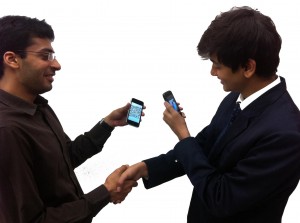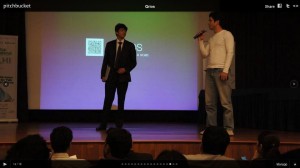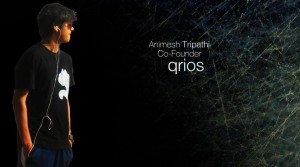
Ever found yourself constantly collecting business cards and entering names and phone numbers into your phone? Tired of the awkward social dance of giving numbers, waiting for the other person to call, hanging up, storing the number, and asking several times how to spell a last name?
There’s an easier way out. Try Qrios!
Qrios is the brainchild of 16 year old boy genius, Animesh Tripathi from New Delhi, India. I met Animesh on the new social network sensation, Sumazi. After several emails back and forth, I realized I had met an amazing young man who has revolutionized the use of QR (Quick Reference) Codes.
Philippe Matthews
How did you learn about Sumazi.com?
Animesh Tripathi
I heard about it through someone I was following on Facebook.
Philippe Matthews
What are QR codes?
Animesh Tripathi
QR stands for Quick Response. QR codes are a type of barcodes which were first introduced by Toyota for their vehicles. They have subsequently been used in advertising, marketing, digital and social media, and several other fields.
Philippe Matthews
What can be put on QR codes?
Animesh Tripathi
Since QR codes can contain links to the Internet, they can contain just about anything , be it images, text, websites, blogs, contact info or anything else on the World Wide Web. QR codes can also be used offline, that is, independent of the internet.However, the capability of QR codes for offline use is limited, since they can contain only about 1500 characters. (Bigger QR codes can contain more characters, but they’re usually not practical or accurate enough to be widely adopted). This is not enough data for most applications, and hence, linking QRs to data on the web helps a lot.
Philippe Matthews
How are QR codes used in mobile technology?
Animesh Tripathi
QR codes are used mostly by brands to advertise exclusive offerings, discounts or such, or as a ‘learn more’ link for brochures/introductory advertisements.
Recently, Perx is a startup which has used QR codes for a loyalty-reward platform.
Philippe Matthews
What makes Qrios unique in the digital marketplace?
Animesh Tripathi
QR codes have widely been used for advertising, be it print, online or offline. They have been described as a link between the offline and online world. But they haven’t been used for identification. Since they’re portable, fast and accurate, they offer a perfect medium of storing personal information and exchanging this info on the go, or using it to sign up for events/memberships. It’s like a Facebook/Twitter Connect system for the offline world. So the information is stored on the cloud, and it’s used as a universal database for every activity or service which the user utilises. It’s a new, global, personal UID.
Philippe Matthews
How did you come up with the concept of Qrios?
 Animesh Tripathi
Animesh Tripathi
Qrios was quite a brainwave. I had been interested in entrepreneurship and startups since quite some time, and I had been designing websites professionally since I was fourteen.
My mother had signed up for the American Center newsletter. Incidentally, the Startup Weekend was being held at the American Center. When she suggested that I go there, I said ‘no’.
But I went on to see what the Startup Weekend was about. I was immediately interested. I hadn’t attended such an event before, so this was something new for me. I went over to the website to have a look at the schedule for the New Delhi event.
It described the procedures, how you had to pitch an idea on Friday, people would vote for the top ideas, which would then turn into startup projects that we would work on and present to a panel of VCs and serial entrepreneurs on Sunday.
I thought “This is not for me. I won’t be able to network. I don’t have a clear startup idea, and no one will take me into their team. What would I do if no one voted for my idea? Would I just sit in a corner and watch the others the entire weekend?” all these questions were in my head, and I was nervous about actually going there and pitching my idea.
Finally, after talking to the event managers and getting a 30% off coupon code for the online registration, I signed up for the Startup Weekend, on the day it was starting.
The idea of making the process of identification easier for people had been in my mind for some time, but I needed a medium with which this could be done. I realised that QR codes were the best answer. They could be digital or real, they are portable, easy to generate and use, widespread, and easily identifiable.
They’ve often been described as a ‘link’ from the offline to the online world. I said-”It would be so much easier to meet, socialize and network with this!”. So, I attended the Startup Weekend, pitched my idea (two, in fact), and surprisingly for me, people liked them a lot. The audience of about 200 people then voted for the ideas, and Qrios was voted the 3rd best. I was delighted. I formed a team, we registered a domain, and started work!
Philippe Matthews
That’s amazing! How long did it take for you to develop it?
Animesh Tripathi
During the Startup Weekend, we were focused on building a working prototype, a website that could generate simple, offline QR codes in the vCard format for people. So anyone who registered on Qrios at the time could see a basic QR generator which could generate a vCard (a mobile-friendly contact information file) when scanned.
Interestingly, many people were quite impressed with this basic idea. We set up a computer at our desk to allow registrations. The generated QRs were sent to their email addresses (they would type these while generating the code), and since most of them had smartphones, they would instantly get their QR codes on their phones and start using them.
We took Saturday and Sunday to arrive at this basic functionality. However, this was a very basic version of what we wanted to create.
I developed a networking system based on a some Open Source platforms, where people could register, generate their own profiles, and get unique shortlinks on the websites (qrios.in/something) and their own QR code. The entire process of building the databases, writing code, modifying existing stuff, took me about 2 weeks. Of course, there were hundreds of edits that I did later to modify the appearance and functionality, but these were mostly one step at a time.
Philippe Matthews
What language is it written in?
Animesh Tripathi
The current prototype which we’re use for presentations and demos is an open-source platform customized for Qrios. It allows registration with a MySQL backend, and otherwise, it’s coded in PHP, HTML and CSS. The generator uses a Google API to generate unique QR codes for Qrios profiles.
Philippe Matthews
When did you get interested in technology and writing code?
Animesh Tripathi
I was interested in computers and tech since as far as I can remember, I got my first computer when I was 5. It was a Compaq desktop with a 1.1Ghz Celeron processor with 64MB of RAM and a 20 gigabyte hard disk. We got that for around $1200 then. And I’ve been addicted ever since. I’m told that I used to read a book on Ethical Hacking when I was 8 (or atleast try to) . So yeah. I got interested in code a bit later, though. When I was 7, I learned Flash. The basic animation parts. Then I started venturing and discovered ActionScript, which was the code that was used to make interactions and calculations work inside Flash movies. I started with some ‘start-stop’ coding for animations, and then went on to create interactive interfaces and animations. I started Visual Basic at age 11, and developed some applications. I think I developed an application which calculated and presented the multiples of a number, say ‘n’ upto ‘x’ times. I remember doing another one for a browser which had integrated search results from 4 search engines.
Philippe Matthews
Who are your partners in Qrios?
Animesh Tripathi
Currently, Ashim and me are running Qrios. Ashim has recently taken off from management consulting to enter the world of entrepreneurship. With close to 2 years of due diligence and strategy experience, Ashim wants to explore other opportunities. He pursued his Masters from Cornell University and a summer business program from Tuck School of Business at Dartmouth. We are also consulting with several mentors and serial entrepreneurs who have experience in the startup world to bring forward new ideas for Qrios and improve the existing utility of Qrios as a platform.
Philippe Matthews
How much are you trying to raise for your startup?
 Animesh Tripathi
Animesh Tripathi
We’re looking at around $20,000-$50,000 of angel investment, which will allow us to build up a reasonably well-structured startup, including the technology costs and other development for mobile applications, so that we are ready to accept a user base. Once we gather critical mass, we will look for VC funding.
Philippe Matthews
What has been your most difficult challenge in developing Qrios?
Animesh Tripathi
Even though we’re just starting out, we’ve faced several challenges for Qrios already. At the Startup Weekend, some mentors from Geeks on A Plane visited us and told us about the potential of our idea and to what extent it could be used. It gave us a significant insight at how things work at web and mobile related technologies and startups, and what they need to excel. One of the common questions we were asked was: “NFC is coming up in a couple of months, what are you going to do about that?”. NFC, which stands for Near-Field-Communication, is a new technology which is being integrated in mobile devices for data transfer. It could be described as a secure, fast and more efficient version of Bluetooth. Well, our answer to that was that NFC enabled smartphones would take at least a year to be available in markets. Once they’re available, there won’t be an immediate adoption of NFC. A small percentage of the people would buy NFC enabled smartphones as soon as they are released. Out of the people buying smartphones at that time, most will not be NFC enabled, especially in India and developing countries. Even at the fastest rate, it would take 4-5 years for the entire market to be NFC enabled and people to actually start using NFC payments and exchange. We also faced some problems while developing the business model for the startup, analysing and considering various revenue sources like merchandising and advertisements
Philippe Matthews
What does your parents think about your success and ambition?
Animesh Tripathi
My parents played an important role in the success of my web design projects and startup aspirations. They encouraged me to work on these while still staying focused on my studies. Unlike most Indian parents who would be reluctant to allow their children to participate in extra-curricular events at this level, they were fine with me working for clients and attending events such as the Startup Weekend. They were extremely happy when they heard that my idea had won the 3rd position during the round of pitches on the first day. They have always allowed and encouraged my participation in extracurricular activities.
Philippe Matthews
Do you come from a large family?
Animesh Tripathi
Not really. I live with my Mom, Dad, Grandmother and a younger sister. That’s 5 of us.
Philippe Matthews
What do your parents do?
Animesh Tripathi
My Dad is an officer at the Indian Navy. My Mom is a freelance writer and previously worked as an instructional designer.
Philippe Matthews
What school do you attend?
Animesh Tripathi
I attend Sanskriti School at Chanakyapuri, New Delhi.
Philippe Matthews
What are your favorite games?
 Animesh Tripathi
Animesh Tripathi
I usually play soccer and sometimes, cricket. I’m not very much into video games, but do play some occasionally.
Philippe Matthews
Do you have a favorite platform?
Animesh Tripathi
I love developing for WordPress.ORG
Philippe Matthews
What is your favorite device/gadget and why?
Animesh Tripathi
Currently, my netbook is my favourite. I bought it with my earnings from web design, and that is one factor. Then, I do most of my browsing, research, and minor edits on the web, so the netbook coupled with my wireless connection is my favourite choice. I even listen to music and watch movies on it sometimes. In fact, I’m typing on it at the moment!

 Philippe Matthews Show Guru Advice, Author Reviews, Tech Reviews, Entertainment News
Philippe Matthews Show Guru Advice, Author Reviews, Tech Reviews, Entertainment News








Great to see this guy doing awesome stuff. I love the idea of using QR based systems for something more than advertising.